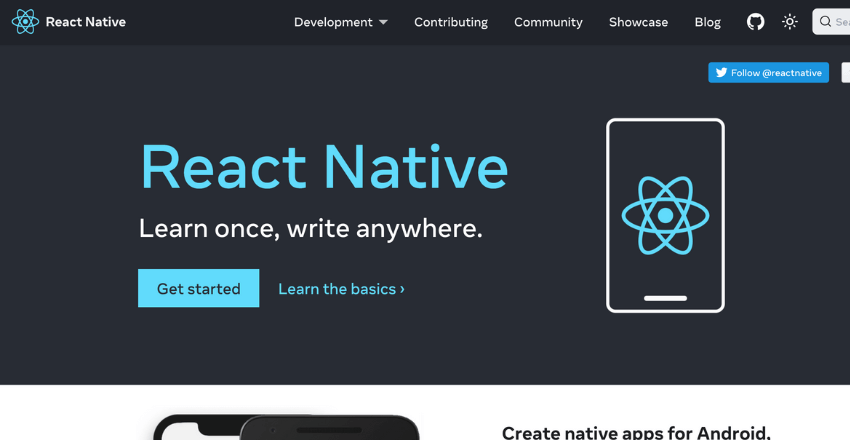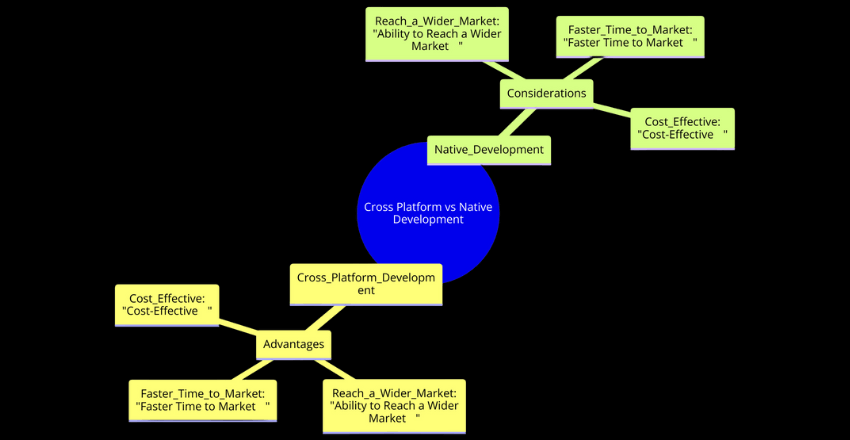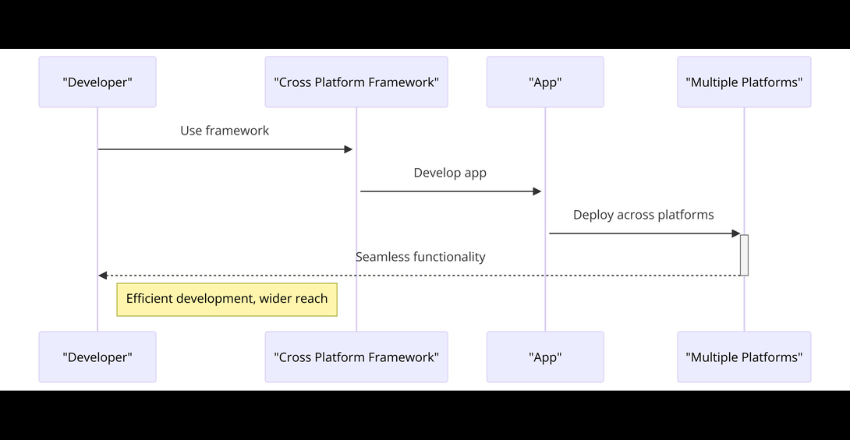
Why cross platform development is becoming more popular: cross-platform development is becoming more popular because it streamlines app production, slashing costs and time-to-market for businesses targeting multiple mobile platforms.
In today’s fast-paced world, the demand for mobile apps and software has been steadily increasing. As technology continues to advance, businesses and developers are constantly seeking efficient and cost-effective ways to meet this demand.
This is where cross platform development comes into play. With the ability to create applications that can run on multiple platforms, such as iOS and Android, cross platform development has become increasingly popular in recent years.
But what exactly is cross platform development? It refers to the process of developing software or mobile apps that can be executed on different operating systems and devices. This approach offers numerous benefits, including increased flexibility, improved efficiency, and reduced development costs.
The rise of cross platform development can be attributed to several factors. Firstly, it allows businesses to reach a wider market by creating apps that can be used by both iOS and Android users. By targeting multiple platforms, developers can maximize their reach and potentially increase their user base.
Moreover, cross platform development enables faster time to market. Instead of creating separate apps for each platform, developers can build a single codebase that can be deployed across multiple platforms. This not only saves time but also streamlines the development process.

Furthermore, the rapid advancements in technology have made cross platform development more feasible and accessible. With the availability of various cross platform development tools and frameworks, developers can easily create high-quality apps that offer a seamless user experience.
The increasing popularity of cross platform development can be attributed to the rising demand for mobile apps and software, as well as the numerous benefits it offers in terms of flexibility, efficiency, and cost-effectiveness. As technology continues to evolve, cross platform development is set to play a vital role in shaping the future of the software and technology industry.
Benefits of Cross Platform Development

When it comes to developing mobile apps, businesses are constantly seeking cost-effective solutions that can reach a wider audience. This is where cross platform development proves to be a game-changer. By leveraging the power of cross platform app development, businesses can enjoy a range of benefits that make it a popular choice in today’s fast-paced digital landscape.
Flexibility and Efficiency
One of the key advantages of cross platform development is the flexibility it offers. With a single codebase, developers can create apps that run seamlessly on multiple platforms, including iOS and Android. This eliminates the need for separate teams and resources for each platform, resulting in significant time and cost savings.
Additionally, cross platform apps enable businesses to efficiently roll out updates and new features across all platforms simultaneously. This ensures a consistent user experience and reduces development cycles, allowing businesses to stay agile in a rapidly evolving market.
Cost-Effectiveness
Developing native apps for each platform can be a costly endeavor. Cross platform development, on the other hand, provides a cost-effective solution by minimizing development and maintenance expenses. By writing code once and deploying it across multiple platforms, businesses can save both time and money, without compromising on quality or functionality.
Furthermore, cross platform development reduces the need for hiring specialized developers for different platforms, streamlining the development process and reducing overhead costs. This cost-effectiveness makes cross platform development an attractive option for small businesses with limited budgets, as well as larger enterprises looking for efficient solutions to scale their app development projects.
Enhanced Reach and Market Penetration
Another notable advantage of cross platform development is its ability to reach a wider audience. By targeting both iOS and Android users, businesses can maximize their market penetration and engage a larger user base. This broadens the scope for attracting customers, driving user acquisition, and ultimately generating higher revenue.
Additionally, cross platform apps have a faster time to market compared to native apps. This means businesses can quickly launch their apps and gain a competitive edge in the market. By capitalizing on the efficiency and speed of cross platform development, businesses can seize opportunities in a timely manner and stay ahead of the competition.
Cross Platform Development Tools and Frameworks
When it comes to cross platform development, having the right tools and frameworks can make all the difference. With the increasing demand for hybrid app development, developers need reliable and efficient solutions to create apps that can run seamlessly across multiple platforms.
1. React Native

React Native is a popular cross platform framework that allows developers to build native apps using JavaScript. Powered by Facebook, React Native offers a rich set of pre-built components and a fast development cycle. With its ability to create truly native experiences, React Native has gained popularity among developers looking for a flexible and efficient cross platform development solution.
2. Flutter

Flutter, developed by Google, is another notable cross platform framework that uses a single codebase to build high-performance, visually appealing apps for iOS and Android. With its customizable UI components and hot-reload feature, Flutter enables developers to create beautiful and responsive apps in record time. Its growing community and extensive documentation make it an ideal choice for those new to cross platform development.
3. Xamarin

Brought to you by Microsoft, Xamarin is a powerful cross platform development tool that allows developers to write code in C# and share it across multiple platforms. Xamarin provides access to native APIs and UI controls, resulting in highly performant apps that feel native on each platform.
Its seamless integration with Visual Studio makes it a preferred choice for developers familiar with the Microsoft ecosystem.
Of course, these are just a few examples of the cross platform development tools and frameworks available in the market. Each option has its strengths and limitations, and choosing the right one depends on various factors such as project requirements, team expertise, and budget.
Comparison of Cross Platform Development Tools and Frameworks
| Framework | Language | Community Support | Performance |
|---|---|---|---|
| React Native | JavaScript | Large and active | Good |
| Flutter | Dart | Rapidly growing | Excellent |
| Xamarin | C# | Established and thriving | Very good |
Note: The performance rating in the table is based on general observations and may vary depending on specific use cases and optimizations implemented by developers.
As cross platform development continues to evolve, new tools and frameworks are constantly emerging. It’s essential for developers to stay updated with the latest trends and developments to make informed decisions and deliver high-quality, cross-platform apps.
Cross Platform Development vs Native Development

When it comes to developing mobile apps, businesses have two main options: cross platform development and native development. Both approaches have their advantages and considerations, but in recent years, cross platform development has been gaining popularity for its unique benefits.
Advantages of Cross Platform Development
Cross platform development offers several advantages over native development, making it an attractive choice for many businesses. One key advantage is the ability to reach a wider market. With cross platform development, businesses can create a single app that can run on multiple platforms, such as iOS and Android, without the need for separate development projects. This allows businesses to tap into a larger user base and maximize their app’s potential reach.
Another advantage is the faster time to market. Cross platform development frameworks, such as React Native and Flutter, offer streamlined development processes and allow developers to write code once and deploy it across multiple platforms. This significantly reduces development time and enables businesses to launch their apps more quickly, giving them a competitive edge in the market.
Additionally, cross platform development is cost-effective. By using a single codebase for multiple platforms, businesses can save on development costs, as they don’t need to hire separate teams for each platform. This not only reduces expenses but also simplifies the development and maintenance process, making it more efficient and manageable.
Here is a table comparing the key advantages of cross platform development versus native development:
| Advantages | Cross Platform Development | Native Development |
|---|---|---|
| Ability to Reach a Wider Market | ✓ | ✗ |
| Faster Time to Market | ✓ | ✗ |
| Cost-Effective | ✓ | ✗ |
As the table shows, cross platform development has clear advantages when it comes to market reach, time to market, and cost-efficiency. These advantages have contributed to the increasing popularity of cross platform development among businesses and developers.
Cross Platform Compatibility

As mobile app development continues to evolve rapidly, cross platform compatibility has emerged as a crucial factor. With multiple devices and platforms in the market, developers face the challenge of creating apps that can seamlessly run across different environments.
Cross platform compatibility ensures that an app can function smoothly on various operating systems such as iOS, Android, and Windows. This compatibility not only enhances user experience but also allows developers to reach a wider audience and maximize the app’s potential market share. In an increasingly interconnected world, where users switch between devices and platforms seamlessly, cross platform compatibility has become a necessity.
With the rise of cross platform development, the industry is witnessing a surge in the popularity of cross platform apps. These apps are developed using frameworks and tools that enable simultaneous deployment on multiple platforms, saving both time and resources. By leveraging shared codebases and reusable components, cross platform development ensures efficiency and cost-effectiveness. As a result, more and more businesses are embracing cross platform development to deliver their apps to a diverse user base.
In today’s mobile app development landscape, it is crucial to stay updated with the latest trends to remain competitive. Let’s take a closer look at the current trends in cross platform development:
- Progressive Web Apps (PWAs): PWAs are gaining popularity as they provide a native-like experience while being developed using web technologies. These apps are accessible through web browsers and offer offline capabilities, push notifications, and seamless updates.
- Flutter: Flutter, a cross platform development framework by Google, has gained traction due to its fast performance and beautiful UI. Its hot reload feature allows developers to see real-time changes, making the development process more efficient.
- React Native: React Native, another cross platform framework, enables developers to write code in JavaScript and deploy it on multiple platforms. It offers a rich ecosystem of ready-to-use components, speeding up the development process.
- Blockchain-based Apps: Blockchain technology is making its way into the mobile app development landscape, and cross platform apps are no exception. Blockchain-based apps offer enhanced security, transparency, and decentralization, making them attractive for various industries.
As we can see, cross platform development continues to evolve with new tools, frameworks, and technologies. Developers are constantly exploring innovative ways to deliver high-quality cross platform apps that meet the diverse needs of users. With the increasing demand for mobile apps and the advantages offered by cross platform development, the rise of cross platform apps is set to continue.

Meeting the Demand for Cross Platform App Development
The increasing demand for cross platform app development is driving its popularity in the fast-growing mobile app industry. As more businesses recognize the need to reach a wider audience across multiple platforms, the advantages of developing cross platform apps have become increasingly evident.
Cross platform app development refers to the process of creating mobile applications that can run on multiple operating systems, such as iOS and Android. This approach allows developers to write code once and deploy it across different platforms, saving time and effort in the development process. With the rising demand for mobile apps and the need for businesses to expand their market reach, cross platform app development has become a valuable solution.
One of the key advantages of cross platform app development is its ability to reach a wider audience. By developing apps that are compatible with multiple platforms, businesses can ensure that their solutions are accessible to a larger user base. This not only maximizes the potential customer reach but also increases the chances of user engagement and conversion.
Additionally, cross platform app development offers cost-effectiveness. By utilizing a single codebase, businesses can save time and resources compared to developing separate native apps for each platform. With the ability to share code across platforms, developers can streamline the development process and release apps more quickly. This faster time to market is crucial for businesses looking to stay competitive in the rapidly evolving app market.
The advantages of meeting the demand for cross platform app development:
- Wider audience reach: Develop apps that run on multiple platforms.
- Cost-effectiveness: Save time and resources by utilizing a single codebase.
- Faster time to market: Streamline the development process and release apps more quickly.
| Advantages of Cross Platform App Development | Benefits |
|---|---|
| Wider audience reach | Access a larger user base and increase user engagement |
| Cost-effectiveness | Save time and resources with a single codebase |
| Faster time to market | Stay competitive by releasing apps more quickly |
Wrapping Up

Cross platform development is the future of mobile apps and software. It offers numerous benefits such as wider reach, cost-effectiveness, and adaptability to evolving technology trends. As the demand for cross platform solutions continues to grow, embracing this approach will position businesses at the forefront of the industry, ensuring their products can thrive in the competitive digital landscape.
External Resources
https://dotnet.microsoft.com/en-us/apps/xamarin
FAQ

FAQ 1: How does cross-platform development enhance code reuse and save time?
Answer:
Cross-platform development frameworks like React Native or Flutter allow developers to write a single codebase that runs on multiple platforms, primarily iOS and Android. This approach significantly reduces development time and effort by reusing code across platforms, rather than writing separate codebases for each platform. Here’s an example using React Native, demonstrating how a single component can be used on both iOS and Android:
Code Sample: React Native Component
import React from 'react';
import { Text, View } from 'react-native';
const WelcomeMessage = () => (
<View>
<Text>Welcome to Cross-Platform Development!</Text>
</View>
);
export default WelcomeMessage;Explanation:
This React Native example illustrates a simple component that displays a welcome message. The same code can be executed on both iOS and Android platforms without any modifications, showcasing the power of code reuse in cross-platform development. This capability is a key reason why cross-platform development is becoming more popular, as it leads to faster development cycles and reduced costs.
FAQ 2: How does cross-platform development contribute to a consistent user experience across different devices?
Answer:
Cross-platform development frameworks ensure that an application behaves and looks consistent across various devices and platforms. This uniformity is crucial for maintaining brand identity and ensuring a seamless user experience, regardless of the device used. Here’s a Flutter example that demonstrates building a UI that looks consistent on both iOS and Android:
Code Sample: Flutter UI Component
import 'package:flutter/material.dart';
void main() => runApp(MyApp());
class MyApp extends StatelessWidget {
@override
Widget build(BuildContext context) {
return MaterialApp(
home: Scaffold(
appBar: AppBar(
title: Text('Cross-Platform UI Consistency'),
),
body: Center(
child: Text('Hello, Flutter!'),
),
),
);
}
}Explanation:
This Flutter example shows how to create a simple application with a consistent UI on all platforms. Flutter renders its own widgets, which means it can provide a consistent look and feel on any platform.
This approach eliminates inconsistencies that might arise from using different UI components on different platforms, further popularizing cross-platform development for its ability to deliver a unified user experience.
FAQ 3: What role does the community and ecosystem play in the rising popularity of cross-platform development?
Answer:
The vibrant community and rich ecosystem surrounding cross-platform development frameworks significantly contribute to their popularity. These communities offer extensive libraries, plugins, and tools that simplify adding complex functionalities to apps without starting from scratch. Additionally, community support, including forums and tutorials, accelerates the learning curve for new developers. Here’s an example of leveraging a community plugin in React Native:
Code Sample: Using a React Native Plugin
import CameraRoll from '@react-native-community/cameraroll';
// Function to save an image to the camera roll
const saveImage = async (imageUri) => {
try {
await CameraRoll.save(imageUri, 'photo');
console.log('Image saved to the camera roll.');
} catch (error) {
console.error('Error saving image: ', error);
}
};Explanation:
This code snippet demonstrates using the @react-native-community/cameraroll plugin to save an image to the device’s camera roll. The availability of such plugins, developed and maintained by the community, showcases how cross-platform frameworks can quickly integrate device-specific functionalities, enhancing the developer experience.
The strong community and ecosystem support are pivotal reasons behind the growing preference for cross-platform development, as they reduce development time, cost, and complexity

Charlotte Williams is a talented technical author specializing in cross-platform app development. With a diverse professional background, she has gained valuable experience at renowned companies such as Alibaba and Accenture. Charlotte’s journey in the tech industry began as a mobile UX designer back in 2007, allowing her to develop a keen understanding of user-centric app design.
Proficient in utilizing frameworks like React Native and Flutter, Charlotte excels in building cross-platform mobile apps and imparting her knowledge to aspiring developers. She pursued a degree in Computer Science at Cornell University, equipping her with a strong foundation in the field. Residing in San Francisco with her three beloved dogs, she finds solace in hiking the hills and connecting with nature. Charlotte’s passion for app development, combined with her dedication to sharing expertise, makes her an invaluable resource in the world of cross-platform app development.






